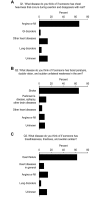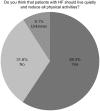Heart failure awareness in the Korean general population: Results from the nationwide survey
- PMID: 31491021
- PMCID: PMC6731018
- DOI: 10.1371/journal.pone.0222264
Heart failure awareness in the Korean general population: Results from the nationwide survey
Abstract
Background: For a better heart failure outcome, it is fundamental to improve the awareness of heart failure at the general population level. We conducted this study to identify the current status of awareness of heart failure in the Korean general population.
Methods: This cross-sectional nationwide survey recruited a total of 1,032 participants aged 30 years or older, based on a stratification systematic sampling method. A 23-item questionnaire was surveyed through telephone interviews.
Results: Although 80% of the participants had heard of heart failure, 47% exactly defined what heart failure is. A minority of participants correctly recognized the lifetime risk of developing heart failure (21%) as well as the mortality (16%) and readmission risk (18%) of heart failure and the cost burden of heart failure admission (28%). Regarding preferred treatment options, 71% of the participants chose a treatment option that could improve the quality of life. Approximately two-thirds of the participants agreed that current medical treatment could reduce mortality and improve the quality of life. More than half of the participants (59%) thought that heart failure patients should live quietly and reduce all physical activities. Across survey items, we found a lower awareness state in the elderly groups and people at lower income and educational levels.
Conclusions: The current awareness status of heart failure in the Korean general population is still low. Proactive educational efforts should be made to improve public awareness with special attention to individuals with lower disease awareness.
Conflict of interest statement
The authors have declared that no competing interests exist.
Figures



Similar articles
-
Physical Functioning, Physical Activity, Exercise Self-Efficacy, and Quality of Life Among Individuals With Chronic Heart Failure in Korea: A Cross-Sectional Descriptive Study.J Nurs Res. 2017 Apr;25(2):131-139. doi: 10.1097/JNR.0000000000000150. J Nurs Res. 2017. PMID: 28277393
-
Factors associated with health-related quality of life in Koreans aged over 50 Years: the fourth and fifth Korea National Health and Nutrition Examination Survey.Health Qual Life Outcomes. 2017 Dec 16;15(1):243. doi: 10.1186/s12955-017-0816-4. Health Qual Life Outcomes. 2017. PMID: 29246226 Free PMC article.
-
Awareness and practice of breast self-examination among Korean women: results from a nationwide survey.Asian Pac J Cancer Prev. 2012;13(1):123-5. doi: 10.7314/apjcp.2012.13.1.123. Asian Pac J Cancer Prev. 2012. PMID: 22502653 Clinical Trial.
-
Predictors of noticing stroke educational campaign.J Stroke Cerebrovasc Dis. 2014 Jul;23(6):1662-8. doi: 10.1016/j.jstrokecerebrovasdis.2014.01.013. Epub 2014 Apr 13. J Stroke Cerebrovasc Dis. 2014. PMID: 24725812
-
A correlational study of illness knowledge, self-care behaviors, and quality of life in elderly patients with heart failure.J Nurs Res. 2014 Jun;22(2):136-45. doi: 10.1097/JNR.0000000000000024. J Nurs Res. 2014. PMID: 24821421
Cited by
-
Heart Failure Awareness Among the General Saudi Population: A Cross-Sectional Study.Cureus. 2023 Jul 18;15(7):e42077. doi: 10.7759/cureus.42077. eCollection 2023 Jul. Cureus. 2023. PMID: 37602039 Free PMC article.
-
Factors Associated with Low Awareness of Heart Failure in the General Population of Korea.Korean Circ J. 2020 Jul;50(7):586-595. doi: 10.4070/kcj.2019.0401. Epub 2020 Mar 12. Korean Circ J. 2020. PMID: 32212427 Free PMC article.
-
Public Awareness of Heart Failure Among the Population of Makkah City, Saudi Arabia: A Cross-Sectional Study.Cureus. 2023 Dec 14;15(12):e50504. doi: 10.7759/cureus.50504. eCollection 2023 Dec. Cureus. 2023. PMID: 38226129 Free PMC article.
-
Knowledge, Health Education, and Mobile Health Strategies on Cardiovascular Disease Awareness in Women: A Narrative Review.J Midlife Health. 2024 Oct-Dec;15(4):228-239. doi: 10.4103/jmh.jmh_163_24. Epub 2025 Jan 2. J Midlife Health. 2024. PMID: 39959732 Free PMC article. Review.
-
Awareness of cardiovascular disease among Korean women: Results from a nationwide survey.Prev Med Rep. 2022 Jan 19;26:101698. doi: 10.1016/j.pmedr.2022.101698. eCollection 2022 Apr. Prev Med Rep. 2022. PMID: 35111568 Free PMC article.
References
-
- Heidenreich PA, Albert NM, Allen LA, Bluemke DA, Butler J, Fonarow GC, et al.; American Heart Association Advocacy Coordinating Committee; Council on Arteriosclerosis, Thrombosis and Vascular Biology; Council on Cardiovascular Radiology and Intervention; Council on Clinical Cardiology; Council on Epidemiology and Prevention; Stroke Council. Forecasting the impact of heart failure in the United Stages: a policy statement from the American Heart Association. Circ Heart Fail. 2013;6: 606–619. 10.1161/HHF.0b013e318291329a - DOI - PMC - PubMed
MeSH terms
LinkOut - more resources
Full Text Sources
Medical

